T2 2019 HA3042 Taxation Law Assignment: Individual Analysis
VerifiedAdded on 2022/11/07
|9
|2331
|237
Homework Assignment
AI Summary
This assignment solution addresses various aspects of taxation law, providing detailed answers to two key questions. The first part focuses on capital gains tax, examining scenarios involving the sale of a family home, a car, a business, furniture, and paintings. It analyzes the tax implications of each asset, considering relevant exemptions and concessions. The second part delves into the depreciation of a CNC machine, discussing the inclusion of various costs like acquisition, installation, and the addition of spare parts. It clarifies when depreciation starts and which costs are included in the total asset value for tax purposes. The solution references relevant tax laws and provides a comprehensive understanding of taxation principles.
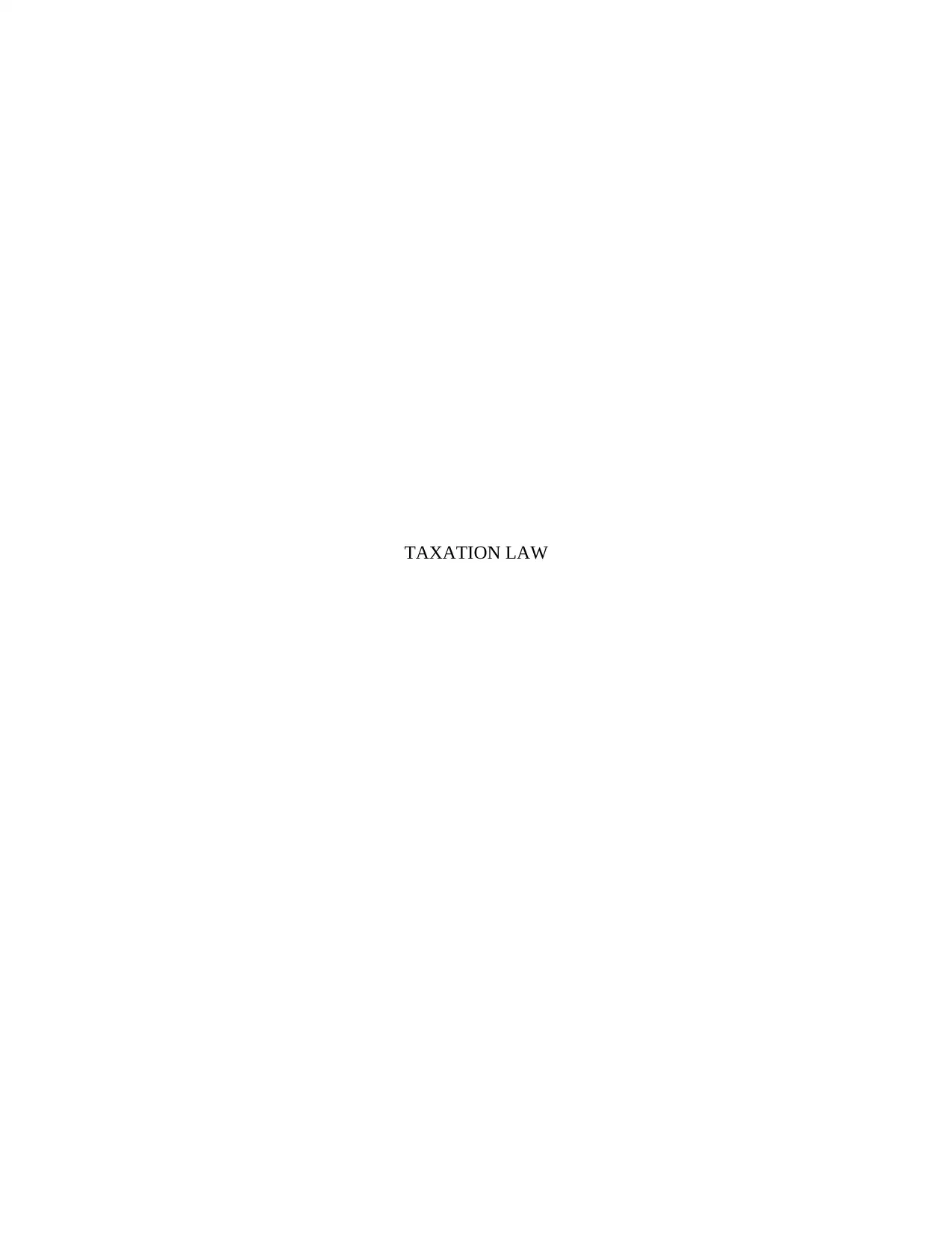
TAXATION LAW
Paraphrase This Document
Need a fresh take? Get an instant paraphrase of this document with our AI Paraphraser
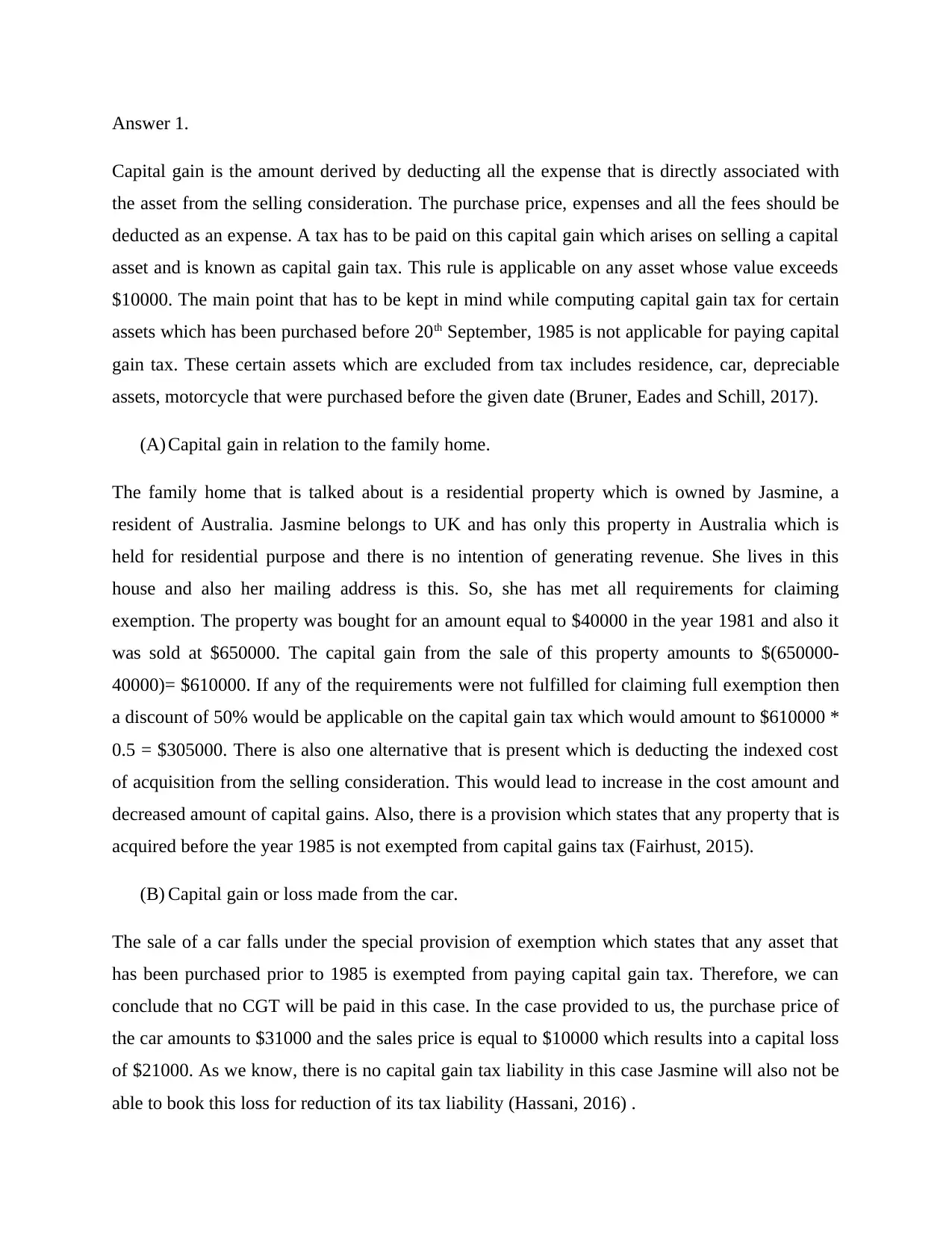
Answer 1.
Capital gain is the amount derived by deducting all the expense that is directly associated with
the asset from the selling consideration. The purchase price, expenses and all the fees should be
deducted as an expense. A tax has to be paid on this capital gain which arises on selling a capital
asset and is known as capital gain tax. This rule is applicable on any asset whose value exceeds
$10000. The main point that has to be kept in mind while computing capital gain tax for certain
assets which has been purchased before 20th September, 1985 is not applicable for paying capital
gain tax. These certain assets which are excluded from tax includes residence, car, depreciable
assets, motorcycle that were purchased before the given date (Bruner, Eades and Schill, 2017).
(A) Capital gain in relation to the family home.
The family home that is talked about is a residential property which is owned by Jasmine, a
resident of Australia. Jasmine belongs to UK and has only this property in Australia which is
held for residential purpose and there is no intention of generating revenue. She lives in this
house and also her mailing address is this. So, she has met all requirements for claiming
exemption. The property was bought for an amount equal to $40000 in the year 1981 and also it
was sold at $650000. The capital gain from the sale of this property amounts to $(650000-
40000)= $610000. If any of the requirements were not fulfilled for claiming full exemption then
a discount of 50% would be applicable on the capital gain tax which would amount to $610000 *
0.5 = $305000. There is also one alternative that is present which is deducting the indexed cost
of acquisition from the selling consideration. This would lead to increase in the cost amount and
decreased amount of capital gains. Also, there is a provision which states that any property that is
acquired before the year 1985 is not exempted from capital gains tax (Fairhust, 2015).
(B) Capital gain or loss made from the car.
The sale of a car falls under the special provision of exemption which states that any asset that
has been purchased prior to 1985 is exempted from paying capital gain tax. Therefore, we can
conclude that no CGT will be paid in this case. In the case provided to us, the purchase price of
the car amounts to $31000 and the sales price is equal to $10000 which results into a capital loss
of $21000. As we know, there is no capital gain tax liability in this case Jasmine will also not be
able to book this loss for reduction of its tax liability (Hassani, 2016) .
Capital gain is the amount derived by deducting all the expense that is directly associated with
the asset from the selling consideration. The purchase price, expenses and all the fees should be
deducted as an expense. A tax has to be paid on this capital gain which arises on selling a capital
asset and is known as capital gain tax. This rule is applicable on any asset whose value exceeds
$10000. The main point that has to be kept in mind while computing capital gain tax for certain
assets which has been purchased before 20th September, 1985 is not applicable for paying capital
gain tax. These certain assets which are excluded from tax includes residence, car, depreciable
assets, motorcycle that were purchased before the given date (Bruner, Eades and Schill, 2017).
(A) Capital gain in relation to the family home.
The family home that is talked about is a residential property which is owned by Jasmine, a
resident of Australia. Jasmine belongs to UK and has only this property in Australia which is
held for residential purpose and there is no intention of generating revenue. She lives in this
house and also her mailing address is this. So, she has met all requirements for claiming
exemption. The property was bought for an amount equal to $40000 in the year 1981 and also it
was sold at $650000. The capital gain from the sale of this property amounts to $(650000-
40000)= $610000. If any of the requirements were not fulfilled for claiming full exemption then
a discount of 50% would be applicable on the capital gain tax which would amount to $610000 *
0.5 = $305000. There is also one alternative that is present which is deducting the indexed cost
of acquisition from the selling consideration. This would lead to increase in the cost amount and
decreased amount of capital gains. Also, there is a provision which states that any property that is
acquired before the year 1985 is not exempted from capital gains tax (Fairhust, 2015).
(B) Capital gain or loss made from the car.
The sale of a car falls under the special provision of exemption which states that any asset that
has been purchased prior to 1985 is exempted from paying capital gain tax. Therefore, we can
conclude that no CGT will be paid in this case. In the case provided to us, the purchase price of
the car amounts to $31000 and the sales price is equal to $10000 which results into a capital loss
of $21000. As we know, there is no capital gain tax liability in this case Jasmine will also not be
able to book this loss for reduction of its tax liability (Hassani, 2016) .
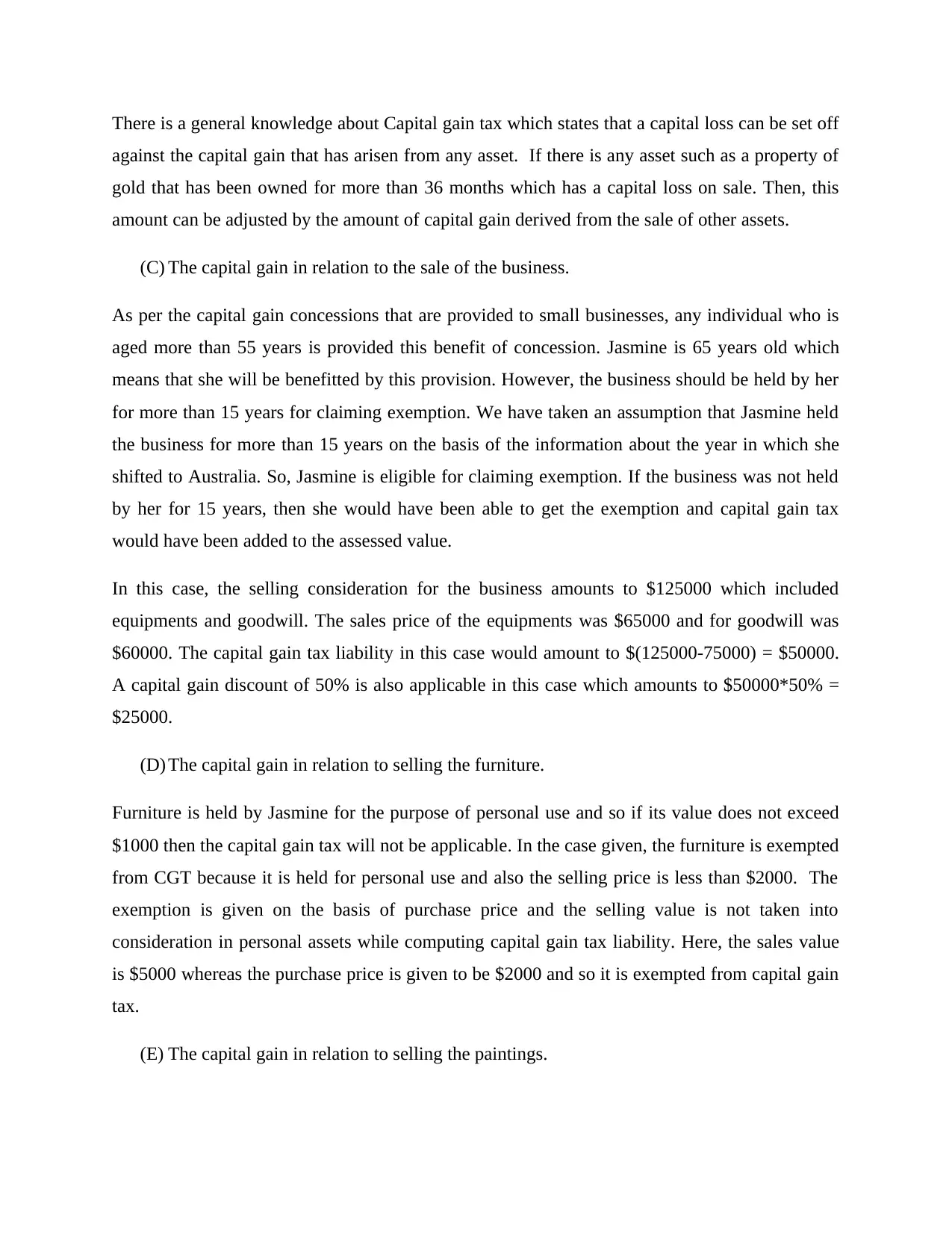
There is a general knowledge about Capital gain tax which states that a capital loss can be set off
against the capital gain that has arisen from any asset. If there is any asset such as a property of
gold that has been owned for more than 36 months which has a capital loss on sale. Then, this
amount can be adjusted by the amount of capital gain derived from the sale of other assets.
(C) The capital gain in relation to the sale of the business.
As per the capital gain concessions that are provided to small businesses, any individual who is
aged more than 55 years is provided this benefit of concession. Jasmine is 65 years old which
means that she will be benefitted by this provision. However, the business should be held by her
for more than 15 years for claiming exemption. We have taken an assumption that Jasmine held
the business for more than 15 years on the basis of the information about the year in which she
shifted to Australia. So, Jasmine is eligible for claiming exemption. If the business was not held
by her for 15 years, then she would have been able to get the exemption and capital gain tax
would have been added to the assessed value.
In this case, the selling consideration for the business amounts to $125000 which included
equipments and goodwill. The sales price of the equipments was $65000 and for goodwill was
$60000. The capital gain tax liability in this case would amount to $(125000-75000) = $50000.
A capital gain discount of 50% is also applicable in this case which amounts to $50000*50% =
$25000.
(D) The capital gain in relation to selling the furniture.
Furniture is held by Jasmine for the purpose of personal use and so if its value does not exceed
$1000 then the capital gain tax will not be applicable. In the case given, the furniture is exempted
from CGT because it is held for personal use and also the selling price is less than $2000. The
exemption is given on the basis of purchase price and the selling value is not taken into
consideration in personal assets while computing capital gain tax liability. Here, the sales value
is $5000 whereas the purchase price is given to be $2000 and so it is exempted from capital gain
tax.
(E) The capital gain in relation to selling the paintings.
against the capital gain that has arisen from any asset. If there is any asset such as a property of
gold that has been owned for more than 36 months which has a capital loss on sale. Then, this
amount can be adjusted by the amount of capital gain derived from the sale of other assets.
(C) The capital gain in relation to the sale of the business.
As per the capital gain concessions that are provided to small businesses, any individual who is
aged more than 55 years is provided this benefit of concession. Jasmine is 65 years old which
means that she will be benefitted by this provision. However, the business should be held by her
for more than 15 years for claiming exemption. We have taken an assumption that Jasmine held
the business for more than 15 years on the basis of the information about the year in which she
shifted to Australia. So, Jasmine is eligible for claiming exemption. If the business was not held
by her for 15 years, then she would have been able to get the exemption and capital gain tax
would have been added to the assessed value.
In this case, the selling consideration for the business amounts to $125000 which included
equipments and goodwill. The sales price of the equipments was $65000 and for goodwill was
$60000. The capital gain tax liability in this case would amount to $(125000-75000) = $50000.
A capital gain discount of 50% is also applicable in this case which amounts to $50000*50% =
$25000.
(D) The capital gain in relation to selling the furniture.
Furniture is held by Jasmine for the purpose of personal use and so if its value does not exceed
$1000 then the capital gain tax will not be applicable. In the case given, the furniture is exempted
from CGT because it is held for personal use and also the selling price is less than $2000. The
exemption is given on the basis of purchase price and the selling value is not taken into
consideration in personal assets while computing capital gain tax liability. Here, the sales value
is $5000 whereas the purchase price is given to be $2000 and so it is exempted from capital gain
tax.
(E) The capital gain in relation to selling the paintings.
⊘ This is a preview!⊘
Do you want full access?
Subscribe today to unlock all pages.

Trusted by 1+ million students worldwide
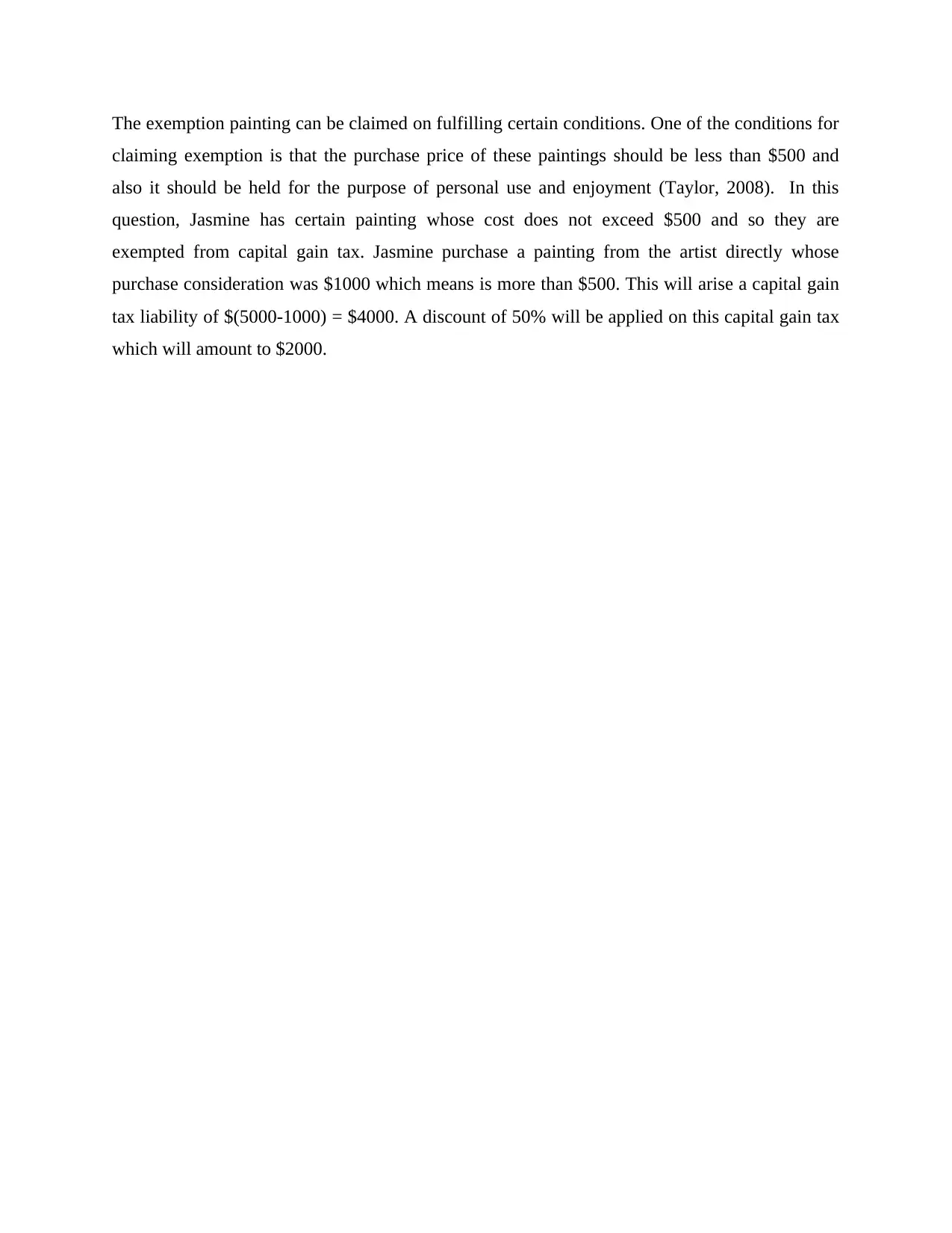
The exemption painting can be claimed on fulfilling certain conditions. One of the conditions for
claiming exemption is that the purchase price of these paintings should be less than $500 and
also it should be held for the purpose of personal use and enjoyment (Taylor, 2008). In this
question, Jasmine has certain painting whose cost does not exceed $500 and so they are
exempted from capital gain tax. Jasmine purchase a painting from the artist directly whose
purchase consideration was $1000 which means is more than $500. This will arise a capital gain
tax liability of $(5000-1000) = $4000. A discount of 50% will be applied on this capital gain tax
which will amount to $2000.
claiming exemption is that the purchase price of these paintings should be less than $500 and
also it should be held for the purpose of personal use and enjoyment (Taylor, 2008). In this
question, Jasmine has certain painting whose cost does not exceed $500 and so they are
exempted from capital gain tax. Jasmine purchase a painting from the artist directly whose
purchase consideration was $1000 which means is more than $500. This will arise a capital gain
tax liability of $(5000-1000) = $4000. A discount of 50% will be applied on this capital gain tax
which will amount to $2000.
Paraphrase This Document
Need a fresh take? Get an instant paraphrase of this document with our AI Paraphraser
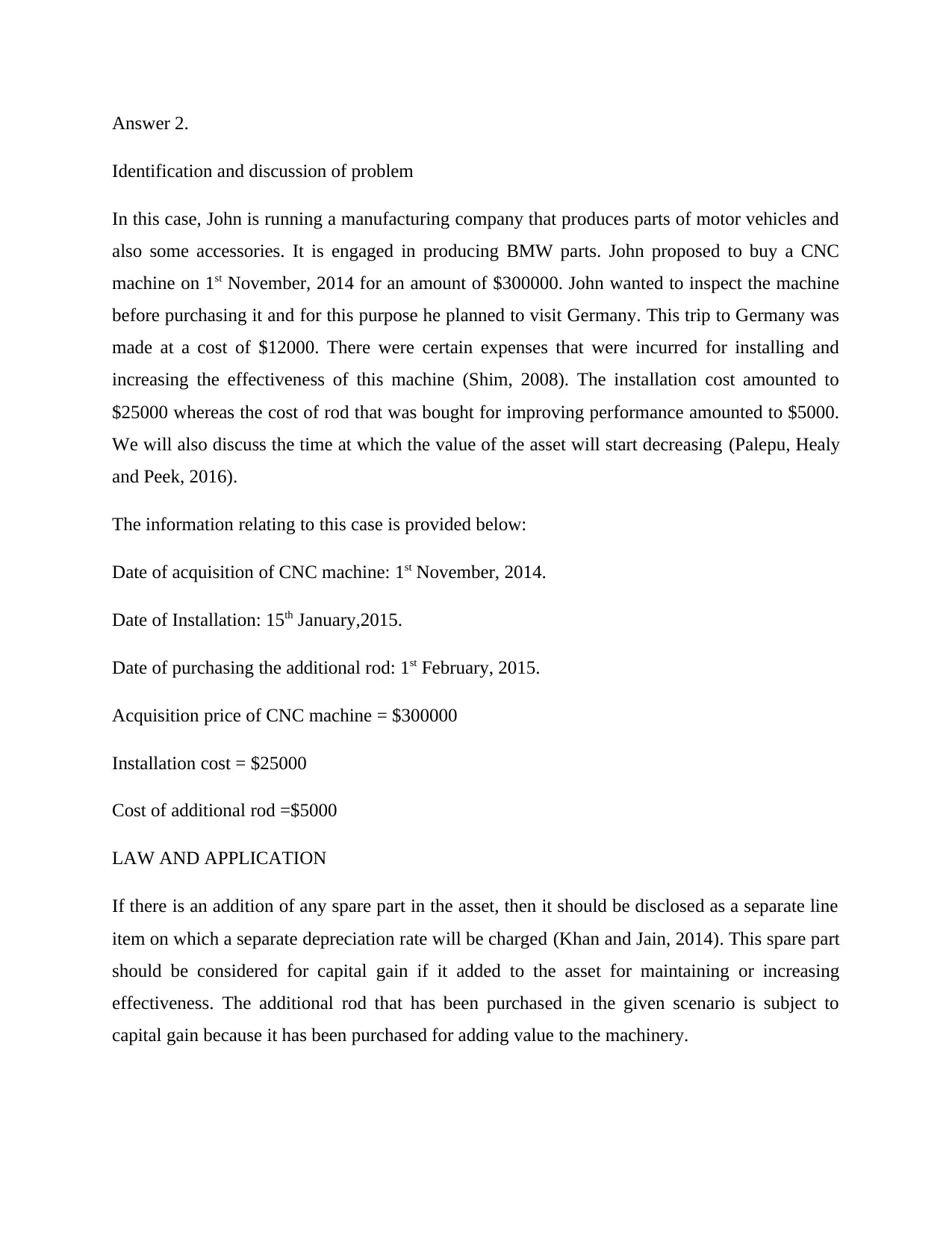
Answer 2.
Identification and discussion of problem
In this case, John is running a manufacturing company that produces parts of motor vehicles and
also some accessories. It is engaged in producing BMW parts. John proposed to buy a CNC
machine on 1st November, 2014 for an amount of $300000. John wanted to inspect the machine
before purchasing it and for this purpose he planned to visit Germany. This trip to Germany was
made at a cost of $12000. There were certain expenses that were incurred for installing and
increasing the effectiveness of this machine (Shim, 2008). The installation cost amounted to
$25000 whereas the cost of rod that was bought for improving performance amounted to $5000.
We will also discuss the time at which the value of the asset will start decreasing (Palepu, Healy
and Peek, 2016).
The information relating to this case is provided below:
Date of acquisition of CNC machine: 1st November, 2014.
Date of Installation: 15th January,2015.
Date of purchasing the additional rod: 1st February, 2015.
Acquisition price of CNC machine = $300000
Installation cost = $25000
Cost of additional rod =$5000
LAW AND APPLICATION
If there is an addition of any spare part in the asset, then it should be disclosed as a separate line
item on which a separate depreciation rate will be charged (Khan and Jain, 2014). This spare part
should be considered for capital gain if it added to the asset for maintaining or increasing
effectiveness. The additional rod that has been purchased in the given scenario is subject to
capital gain because it has been purchased for adding value to the machinery.
Identification and discussion of problem
In this case, John is running a manufacturing company that produces parts of motor vehicles and
also some accessories. It is engaged in producing BMW parts. John proposed to buy a CNC
machine on 1st November, 2014 for an amount of $300000. John wanted to inspect the machine
before purchasing it and for this purpose he planned to visit Germany. This trip to Germany was
made at a cost of $12000. There were certain expenses that were incurred for installing and
increasing the effectiveness of this machine (Shim, 2008). The installation cost amounted to
$25000 whereas the cost of rod that was bought for improving performance amounted to $5000.
We will also discuss the time at which the value of the asset will start decreasing (Palepu, Healy
and Peek, 2016).
The information relating to this case is provided below:
Date of acquisition of CNC machine: 1st November, 2014.
Date of Installation: 15th January,2015.
Date of purchasing the additional rod: 1st February, 2015.
Acquisition price of CNC machine = $300000
Installation cost = $25000
Cost of additional rod =$5000
LAW AND APPLICATION
If there is an addition of any spare part in the asset, then it should be disclosed as a separate line
item on which a separate depreciation rate will be charged (Khan and Jain, 2014). This spare part
should be considered for capital gain if it added to the asset for maintaining or increasing
effectiveness. The additional rod that has been purchased in the given scenario is subject to
capital gain because it has been purchased for adding value to the machinery.
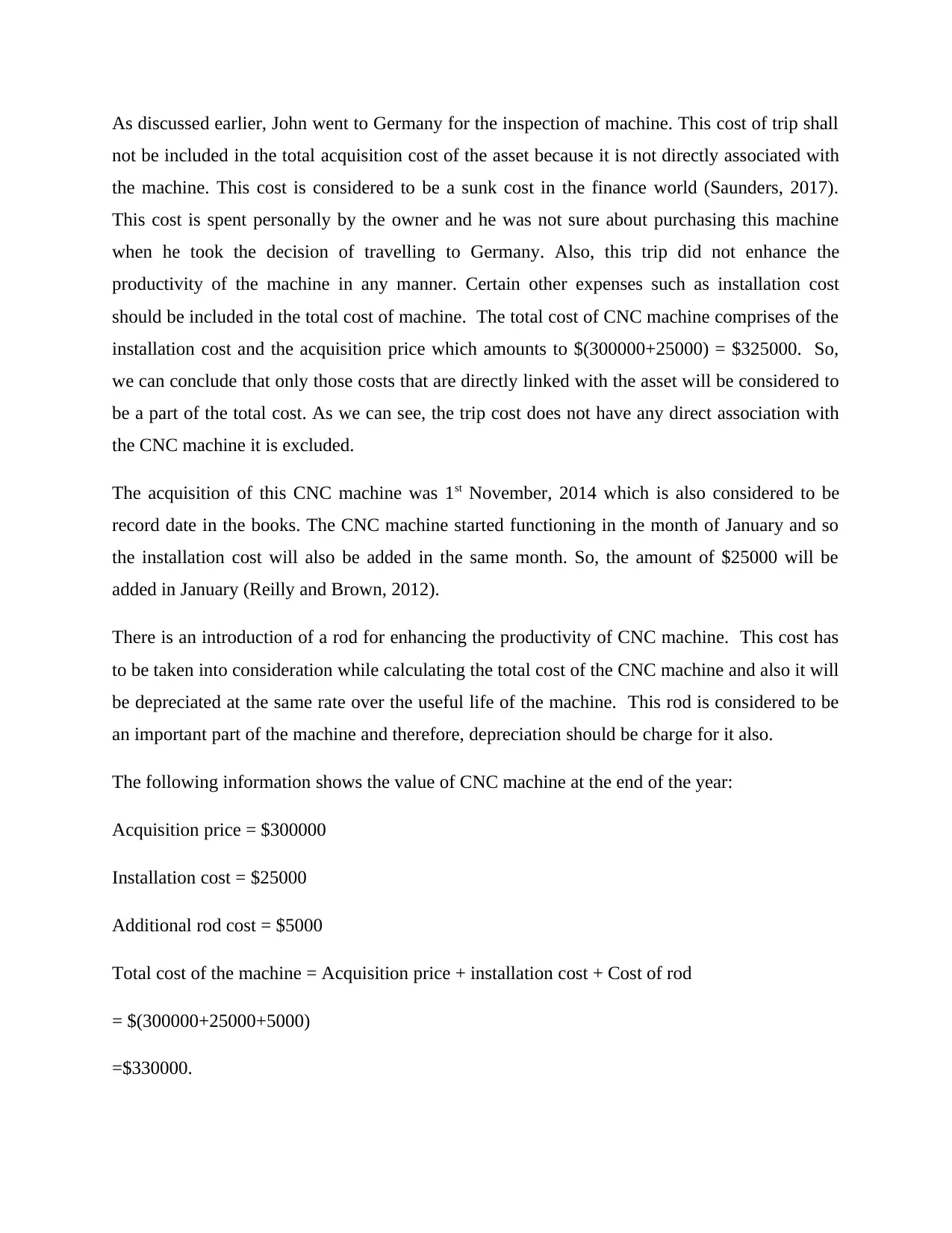
As discussed earlier, John went to Germany for the inspection of machine. This cost of trip shall
not be included in the total acquisition cost of the asset because it is not directly associated with
the machine. This cost is considered to be a sunk cost in the finance world (Saunders, 2017).
This cost is spent personally by the owner and he was not sure about purchasing this machine
when he took the decision of travelling to Germany. Also, this trip did not enhance the
productivity of the machine in any manner. Certain other expenses such as installation cost
should be included in the total cost of machine. The total cost of CNC machine comprises of the
installation cost and the acquisition price which amounts to $(300000+25000) = $325000. So,
we can conclude that only those costs that are directly linked with the asset will be considered to
be a part of the total cost. As we can see, the trip cost does not have any direct association with
the CNC machine it is excluded.
The acquisition of this CNC machine was 1st November, 2014 which is also considered to be
record date in the books. The CNC machine started functioning in the month of January and so
the installation cost will also be added in the same month. So, the amount of $25000 will be
added in January (Reilly and Brown, 2012).
There is an introduction of a rod for enhancing the productivity of CNC machine. This cost has
to be taken into consideration while calculating the total cost of the CNC machine and also it will
be depreciated at the same rate over the useful life of the machine. This rod is considered to be
an important part of the machine and therefore, depreciation should be charge for it also.
The following information shows the value of CNC machine at the end of the year:
Acquisition price = $300000
Installation cost = $25000
Additional rod cost = $5000
Total cost of the machine = Acquisition price + installation cost + Cost of rod
= $(300000+25000+5000)
=$330000.
not be included in the total acquisition cost of the asset because it is not directly associated with
the machine. This cost is considered to be a sunk cost in the finance world (Saunders, 2017).
This cost is spent personally by the owner and he was not sure about purchasing this machine
when he took the decision of travelling to Germany. Also, this trip did not enhance the
productivity of the machine in any manner. Certain other expenses such as installation cost
should be included in the total cost of machine. The total cost of CNC machine comprises of the
installation cost and the acquisition price which amounts to $(300000+25000) = $325000. So,
we can conclude that only those costs that are directly linked with the asset will be considered to
be a part of the total cost. As we can see, the trip cost does not have any direct association with
the CNC machine it is excluded.
The acquisition of this CNC machine was 1st November, 2014 which is also considered to be
record date in the books. The CNC machine started functioning in the month of January and so
the installation cost will also be added in the same month. So, the amount of $25000 will be
added in January (Reilly and Brown, 2012).
There is an introduction of a rod for enhancing the productivity of CNC machine. This cost has
to be taken into consideration while calculating the total cost of the CNC machine and also it will
be depreciated at the same rate over the useful life of the machine. This rod is considered to be
an important part of the machine and therefore, depreciation should be charge for it also.
The following information shows the value of CNC machine at the end of the year:
Acquisition price = $300000
Installation cost = $25000
Additional rod cost = $5000
Total cost of the machine = Acquisition price + installation cost + Cost of rod
= $(300000+25000+5000)
=$330000.
⊘ This is a preview!⊘
Do you want full access?
Subscribe today to unlock all pages.

Trusted by 1+ million students worldwide
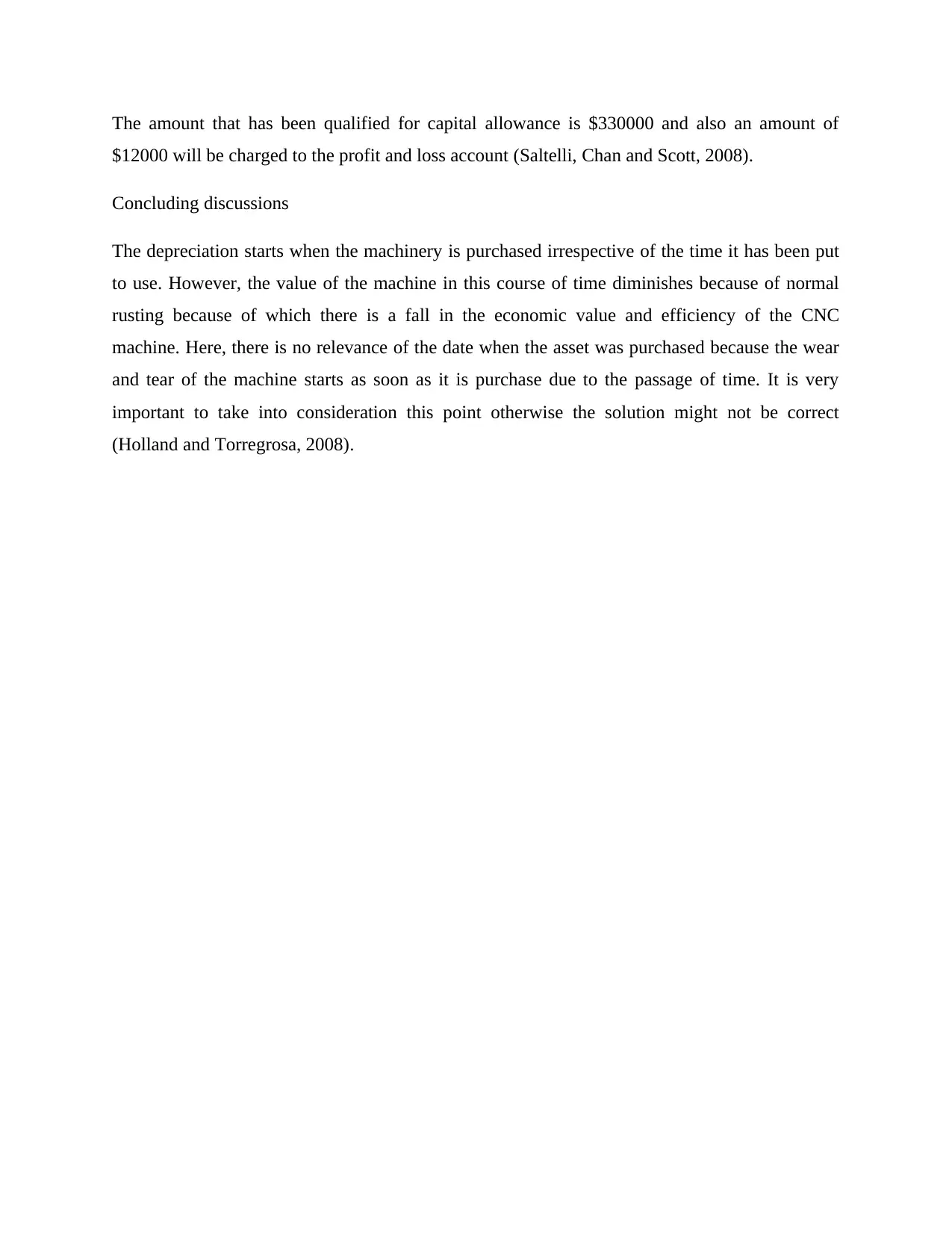
The amount that has been qualified for capital allowance is $330000 and also an amount of
$12000 will be charged to the profit and loss account (Saltelli, Chan and Scott, 2008).
Concluding discussions
The depreciation starts when the machinery is purchased irrespective of the time it has been put
to use. However, the value of the machine in this course of time diminishes because of normal
rusting because of which there is a fall in the economic value and efficiency of the CNC
machine. Here, there is no relevance of the date when the asset was purchased because the wear
and tear of the machine starts as soon as it is purchase due to the passage of time. It is very
important to take into consideration this point otherwise the solution might not be correct
(Holland and Torregrosa, 2008).
$12000 will be charged to the profit and loss account (Saltelli, Chan and Scott, 2008).
Concluding discussions
The depreciation starts when the machinery is purchased irrespective of the time it has been put
to use. However, the value of the machine in this course of time diminishes because of normal
rusting because of which there is a fall in the economic value and efficiency of the CNC
machine. Here, there is no relevance of the date when the asset was purchased because the wear
and tear of the machine starts as soon as it is purchase due to the passage of time. It is very
important to take into consideration this point otherwise the solution might not be correct
(Holland and Torregrosa, 2008).
Paraphrase This Document
Need a fresh take? Get an instant paraphrase of this document with our AI Paraphraser
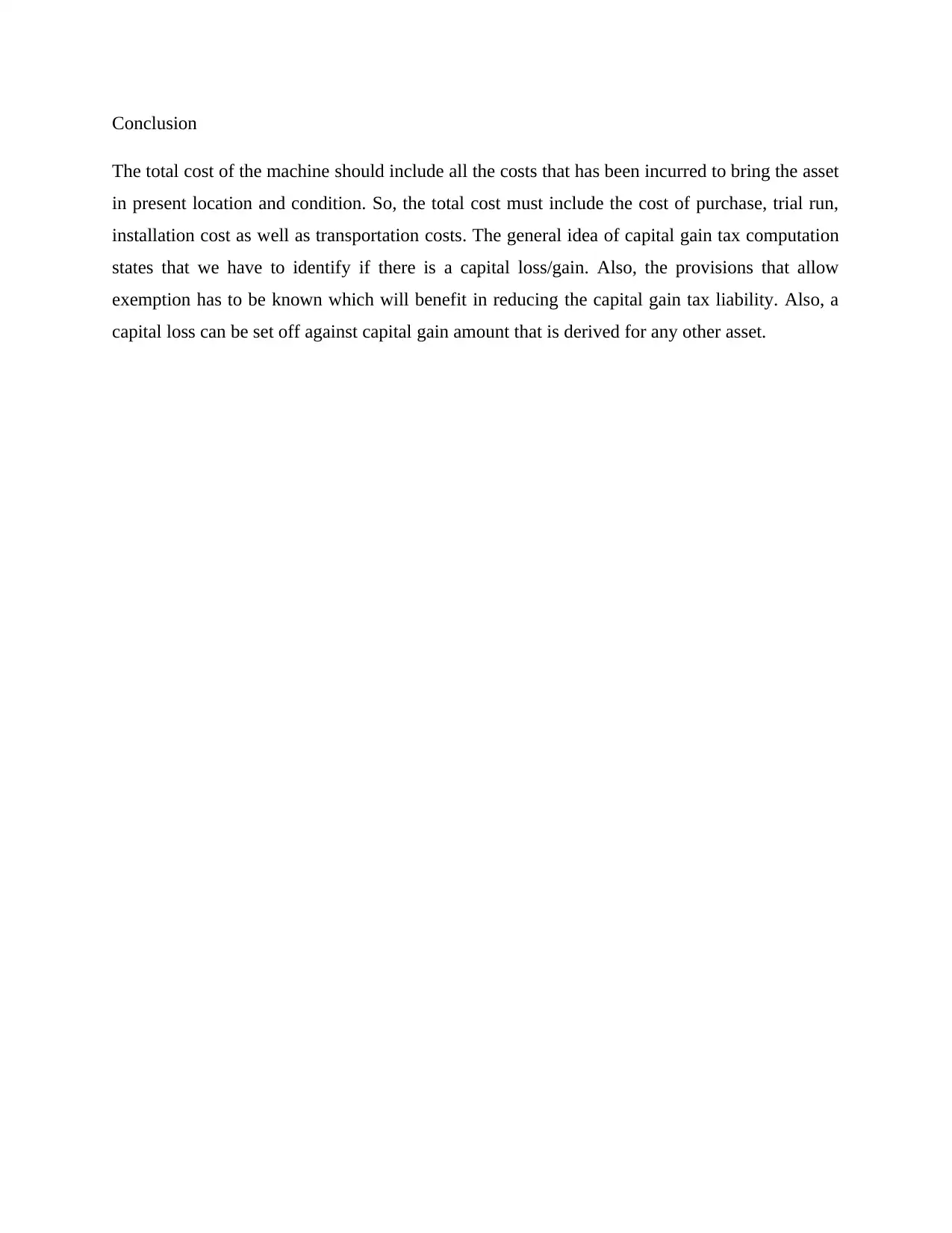
Conclusion
The total cost of the machine should include all the costs that has been incurred to bring the asset
in present location and condition. So, the total cost must include the cost of purchase, trial run,
installation cost as well as transportation costs. The general idea of capital gain tax computation
states that we have to identify if there is a capital loss/gain. Also, the provisions that allow
exemption has to be known which will benefit in reducing the capital gain tax liability. Also, a
capital loss can be set off against capital gain amount that is derived for any other asset.
The total cost of the machine should include all the costs that has been incurred to bring the asset
in present location and condition. So, the total cost must include the cost of purchase, trial run,
installation cost as well as transportation costs. The general idea of capital gain tax computation
states that we have to identify if there is a capital loss/gain. Also, the provisions that allow
exemption has to be known which will benefit in reducing the capital gain tax liability. Also, a
capital loss can be set off against capital gain amount that is derived for any other asset.
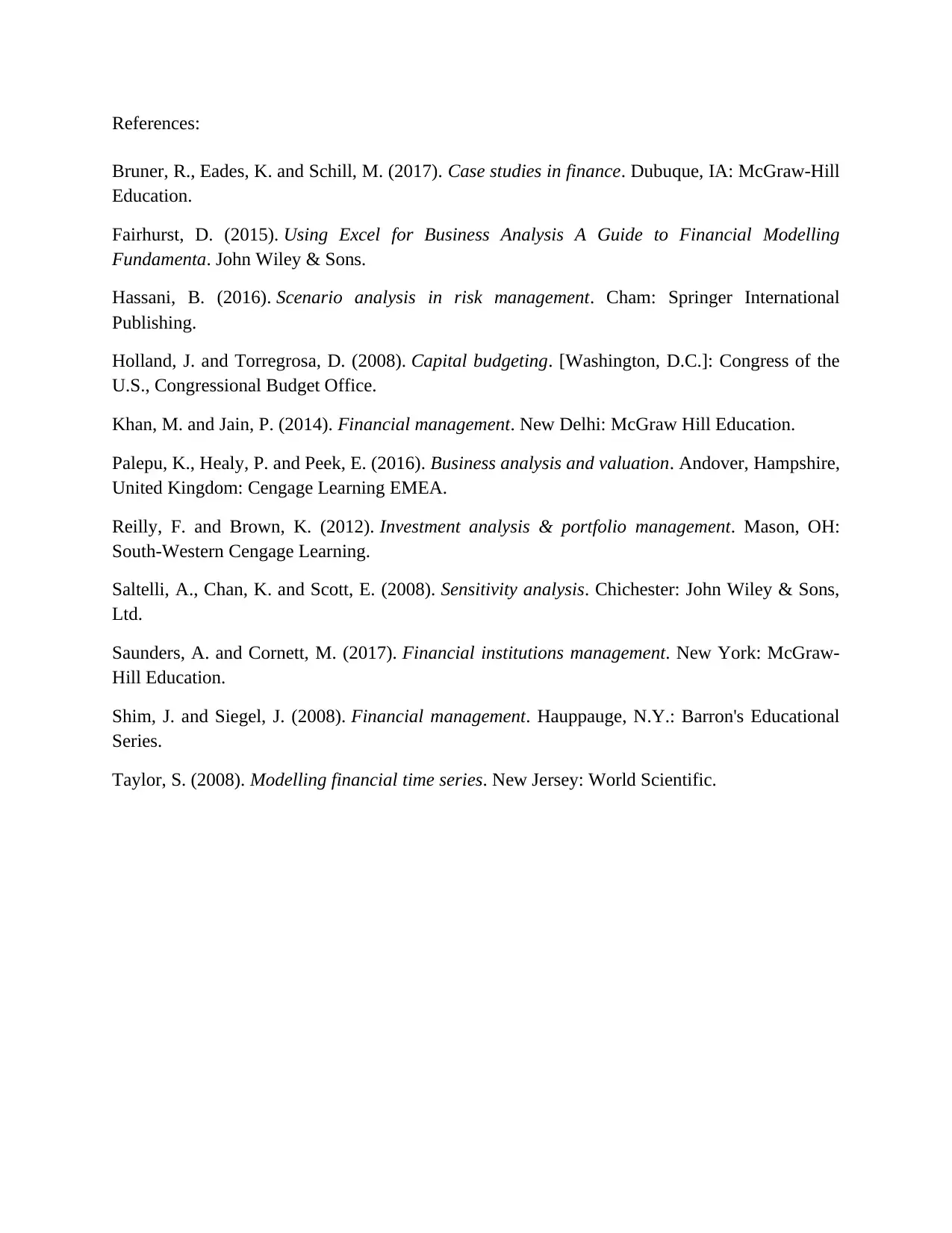
References:
Bruner, R., Eades, K. and Schill, M. (2017). Case studies in finance. Dubuque, IA: McGraw-Hill
Education.
Fairhurst, D. (2015). Using Excel for Business Analysis A Guide to Financial Modelling
Fundamenta. John Wiley & Sons.
Hassani, B. (2016). Scenario analysis in risk management. Cham: Springer International
Publishing.
Holland, J. and Torregrosa, D. (2008). Capital budgeting. [Washington, D.C.]: Congress of the
U.S., Congressional Budget Office.
Khan, M. and Jain, P. (2014). Financial management. New Delhi: McGraw Hill Education.
Palepu, K., Healy, P. and Peek, E. (2016). Business analysis and valuation. Andover, Hampshire,
United Kingdom: Cengage Learning EMEA.
Reilly, F. and Brown, K. (2012). Investment analysis & portfolio management. Mason, OH:
South-Western Cengage Learning.
Saltelli, A., Chan, K. and Scott, E. (2008). Sensitivity analysis. Chichester: John Wiley & Sons,
Ltd.
Saunders, A. and Cornett, M. (2017). Financial institutions management. New York: McGraw-
Hill Education.
Shim, J. and Siegel, J. (2008). Financial management. Hauppauge, N.Y.: Barron's Educational
Series.
Taylor, S. (2008). Modelling financial time series. New Jersey: World Scientific.
Bruner, R., Eades, K. and Schill, M. (2017). Case studies in finance. Dubuque, IA: McGraw-Hill
Education.
Fairhurst, D. (2015). Using Excel for Business Analysis A Guide to Financial Modelling
Fundamenta. John Wiley & Sons.
Hassani, B. (2016). Scenario analysis in risk management. Cham: Springer International
Publishing.
Holland, J. and Torregrosa, D. (2008). Capital budgeting. [Washington, D.C.]: Congress of the
U.S., Congressional Budget Office.
Khan, M. and Jain, P. (2014). Financial management. New Delhi: McGraw Hill Education.
Palepu, K., Healy, P. and Peek, E. (2016). Business analysis and valuation. Andover, Hampshire,
United Kingdom: Cengage Learning EMEA.
Reilly, F. and Brown, K. (2012). Investment analysis & portfolio management. Mason, OH:
South-Western Cengage Learning.
Saltelli, A., Chan, K. and Scott, E. (2008). Sensitivity analysis. Chichester: John Wiley & Sons,
Ltd.
Saunders, A. and Cornett, M. (2017). Financial institutions management. New York: McGraw-
Hill Education.
Shim, J. and Siegel, J. (2008). Financial management. Hauppauge, N.Y.: Barron's Educational
Series.
Taylor, S. (2008). Modelling financial time series. New Jersey: World Scientific.
⊘ This is a preview!⊘
Do you want full access?
Subscribe today to unlock all pages.

Trusted by 1+ million students worldwide
1 out of 9
Related Documents
Your All-in-One AI-Powered Toolkit for Academic Success.
+13062052269
info@desklib.com
Available 24*7 on WhatsApp / Email
![[object Object]](/_next/static/media/star-bottom.7253800d.svg)
Unlock your academic potential
Copyright © 2020–2025 A2Z Services. All Rights Reserved. Developed and managed by ZUCOL.




